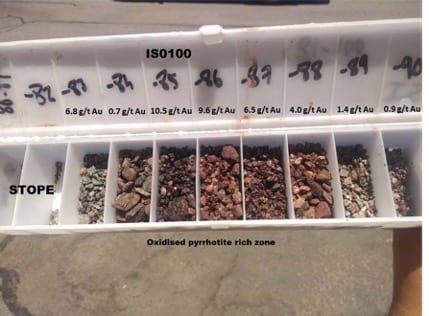RC Drilling Returns Significant Gold Intercepts
Caprice Resources Limited (ASX:CRS) has received significant results from the drilling program at the Baxters-Golconda prospects within the Island Gold Project in the Cue goldfield area of Western Australia.
Executive Director, Scott Patrizi, said the programme was designed to test the along-strike and down-plunge extensions of the high- grade mineralised zones that are known from historical workings and limited exploration.
In total there were 15 RC holes drilled at Baxters-Golconda for a total of 1,573m. The 10 holes at Baxters were drilled along strike and down plunge, stepping out approximately 80m from the previous drilling and historical workings.
Mr Patrizi said Caprice initially tested the area immediately to the north of historic drilling at Baxters. Drilling was successful in identifying the displacement of the Baxters orebody caused by a series of fault jogs in the eastern portion of the drill pattern and will refine the second phase drill program to follow up on this success.
The second phase is scheduled to commence in Q1 CY2021. The most significant intercepts include: 7.0m @ 5.6 g/t Au from 82m incl. 2.0m @ 10.0 g/t Au from 84m; 11.0m @ 3.1 g/t Au from 46m incl. 2.0m @ 10.1 g/t Au from 54m; 4.0m @ 3.2 g/t Au from 63m; and 4.0m @ 3.0 g/t Au from 70m incl. 1m @ 7.2 g/t Au from 72m
Mr Patrizi said Baxters’ main shoot is interpreted to have been faulted to the east. These faults are interpreted to be south easterly thrusts which offset gold mineralisation within the Banded Iron Formation (BIF) and have potentially remobilised gold proximal to the thrusts.
The best intersection was from the deepest and most northerly hole and intercepted 7m @ 5.6 g/t Au from 82-89m (approximately 75m depth from surface). This zone is adjacent to the old North Golconda workings directly below an old stope of 2m from 80-82m.
Mr Patrizi said that importantly, the 7m intercept represents a broader pyrrhotite associated gold bearing altered BIF surrounding the historical stope that was likely targeting a visible high-grade quartz vein.
These workings are not extensive, and it is expected that further complete mineralised zones are expected to continue along strike to the north and will be targeted in future drill programmes.
The drilling at the Golconda prospect, located immediately to the east of Baxters, intersected gold in all five holes. The tenor of the gold is lower than the Baxters shoot, possibly due to structural disturbance along the regional north west trending structure that may have been an important fluid path during mineralisation. Best intercepts included 4m @ 2.3 g/t Au; and 5m @ 1.44 g/t Au.
Some holes intersected intrusive mafics that appear to post-date gold mineralisation. The distribution of these intrusive mafics will be modelled along with the folded BIF unit and faults.
Single regional holes drilled at Vadrians Hill and Ironclad (IS0101 and IS0102) also returned gold mineralisation and were designed to provide information about the orientation of the host BIF in the area for the purpose of future drill planning.
“Our team at Caprice Resources are very excited about the latest round of drilling results from Baxters, which confirms the prospectivity in multiple targets at the Island Gold Project,” Mr Patrizi said.
“This is a ‘target-rich’ system as confirmed by our initial drilling campaign, which has extended high-grade gold mineralisation at New Orient and now at Baxters.
“Our follow up drilling campaign in 2021 will systematically test additional targets that have not been explored using modern methods and continue to extend identified mineralisation at New Orient and Baxters.
“Our technical team are encouraged by their increasing understanding on the controls of gold mineralisation including key structures, and the association of high-grade gold mineralisation with pyrrhotite. This will provide a useful targeting tool using Down Hole Electro-Magnetics, with this survey commencing in the coming weeks.”












